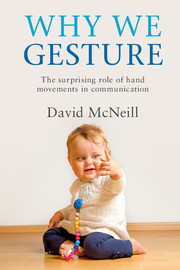Book contents
- Frontmatter
- Dedication
- Contents
- List of figures
- List of tables
- Preface
- Acknowledgments
- Part I Gesture-orchestrated speech
- 1 Why we gesture
- 2 The growth point
- 3 New forms of human action
- 4 Orchestration and unpacking
- 5 Mimicry and metaphor
- Part II Phylogenesis, ontogenesis, brain
- Part III The last page
- References
- Index
3 - New forms of human action
from Part I - Gesture-orchestrated speech
Published online by Cambridge University Press: 05 December 2015
- Frontmatter
- Dedication
- Contents
- List of figures
- List of tables
- Preface
- Acknowledgments
- Part I Gesture-orchestrated speech
- 1 Why we gesture
- 2 The growth point
- 3 New forms of human action
- 4 Orchestration and unpacking
- 5 Mimicry and metaphor
- Part II Phylogenesis, ontogenesis, brain
- Part III The last page
- References
- Index
Summary
Two kinds of action
The argument of this chapter is that gesture-orchestrated speech cannot have practical action sources. This is contrary to a much-taken-for-granted although unconfirmed theory that gestures descend from pragmatic actions. The argument will be that pragmatic actions do not explain why we gesture. When the hands make a gesture, it is one's Being, one's position in the world of meanings that controls them and not a hidden action in relation to the world of objects. Moreover, the two hypotheses cannot be combined; they conflict at the core. Inhabitance of a gesture is not “done.” Whatever its content, it has a different relationship to the person. A pragmatic action relates to the external world. A goal is an intrinsic part of it and cannot be expunged without the action losing an essential part of its significance. Gestures derived from it carry it too (nothing removes it). If Being includes a pragmatic action and goal, it is a separate relationship to speaking (lacking co-expressiveness). The most natural gesture it produces is pantomime, a simulation of action that has the property that it avoids speech, the opposite of gesture-orchestrated speech. Instead, a new form of human action, “new” gesture-action, evolved along with language to perform the gesture-orchestrated speech function. A gesture of wiping something cannot retain the goal of wiping and be co-expressive with “I'm wiping it.” This is because speech does not have the goal of wiping something (an external goal). The goal of speech is to communicate that I'm wiping something (a speaker goal). Pragmatic actions have this one defining property that gestures lack, implicit real-world goals. An implicit goal is an unavoidable consequence of a gesture that descends from a pragmatic action; it automatically includes it. Gesture and speech thus each has a goal the other does not; face-to-face co-expression does not exist; and such a gesture therefore cannot orchestrate speech. For this key reason, gesture-orchestrated speech cannot descend from pragmatic actions.
This chapter also brings further clarification of what is a “gesture,” by distinguishing “new” gesture-actions from practical action-actions, the “old” kind (adjectives referring to phylogenesis: “new” in human evolution versus primate “old,” and as well to the order of emergence in current-day discussions of gesture). The inhabitance mentioned in Chapter 1 is of “new” gesture-actions.
- Type
- Chapter
- Information
- Why We GestureThe Surprising Role of Hand Movements in Communication, pp. 38 - 53Publisher: Cambridge University PressPrint publication year: 2015



